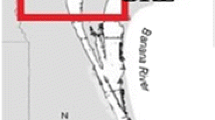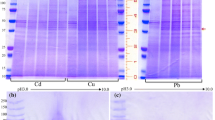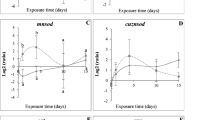Abstract
The ability of Pectinidae to accumulate heavy metals and store them in their tissues allows the use of scallops for biomonitoring marine pollution. High molecular weight metallothionein (MT)-like proteins (MTlps) play a central role in this process. Two major MTlps (72 and 43 kDa) have been identified in the digestive glands of Mizuhopecten yessoensis (Yesso scallop). These proteins have a very high affinity for the heavy metals cadmium, cobalt, and caesium. Additionally, these proteins can be deposited in large quantities in the digestive glands of this mollusc. It has been shown that 72 kDa MTlp is the main stress-response protein in areas polluted with cadmium or radioactive metals. Monitoring the amounts of MTlps in the digestive glands of the scallop M. yessoensis in areas with different anthropogenic pollutants has shown that these proteins are reliable biological markers of heavy-metal pollution in the marine environment.



Similar content being viewed by others
Data availability
The datasets used and/or analysed during the current study are available from the corresponding author on reasonable request.
References
Al Kaddissi S, Frelon S, Elia AC, Legeay A, Gonzalez P, Coppin F, Simon O (2012a) Are antioxidant and transcriptional responses useful for discriminating between chemo- and radiotoxicity of uranium in the crayfish Procambarus clarkii? Ecotoxicol Environ Saf 80:266–272. https://doi.org/10.1016/j.ecoenv.2012.03.010
Al Kaddissi S, Legeay A, Elia AC, Gonzalez P, Camilleri V, Gilbin R, Simon O (2012b) Effects of uranium on crayfish Procambarus clarkii mitochondria and antioxidants responses after chronic exposure: What have we learned? Ecotoxicol Environ Saf 78:218–224. https://doi.org/10.1016/j.ecoenv.2011.11.026
Al Kaddissi S, Simon O, Elia AC, Gonzalez P, Floriani M, Cavalie I, Legeay A (2014) How toxic is the depleted uranium to crayfish Procambarus clarkii compared with cadmium? Environ Toxicol 31(2):211–223. https://doi.org/10.1002/tox.22036
Breitwieser M, Viricel A, Graber M, Murillo L, Becquet V, Churlaud C, Fruitier-Arnaudin I, Huet V, Lacroix C, Pante E, Le Floch S, Thomas-Guyon H (2016) Short-term and long-term biological effects of chronic chemical contamination on natural populations of a marine bivalve. PLoS One 11(3):e0150184. https://doi.org/10.1371/journal.pone.0150184
Buico A, Cassino C, Dondero F, Vergani L, Osella D (2008) Radical scavenging abilities of fish MT-A and mussel MT-10 Metallothionein isoforms: An ESR study. J Inorg Biochem 102(4):921–927. https://doi.org/10.1016/j.jinorgbio.2007.12.012
Chelomin VP, Bobkova EA, Lukyanova ON, Chekmasova NM (1995) Cadmium-induced alterations in essential trace element homeostasis in the tissues of scallop Mizuhopecten yessoensis. Comp Biochem Physiol 110C:329–335. https://doi.org/10.1016/0742-8413(95)95345-c
Chernova AS, Lishavskaya TS, Sevastyanov AV (2011) Concentrations of contaminants in Peter the Great Bay (Japan Sea) in 2004-2008. Izv TINRO 164:330–339
Danilin IA (2010) Metallothioneins kak biomarkeri pri dejstvii na organizmi tyazhelich metallov i ioniziruyschego izlucheniya. Dissertation, RUDN University (In Russian)
Devoid SJ, Etter R, Sugumaran M, Wallace GT, Robinson WE (2007) Hisidine-rich glycoprotein from the hemolymph of the marine mussel Mytilus edulis binds class A, class B, and borderline metals. Environ Toxicol Chem 26(5):872–877
Goryachev VA, Isaeva AA (2007) 60Со in bottom sediments of the Chazhma Bay of the Sea of Japan. Radiochemistry 49:464–466
Goryachev VA, Sergeev AF, Gladkih RV, Soyfer VN, Rubtsov NP, Ivanov VA (2001) The transport of radioactive pollution from Chazhma Bay of Japan sea. Proceedings of the Fifth IOC/WESTPAC International Scientific Symposium. Seoul
Goryachev VA, Isaev AA, Soyfer VN (2009) 60Со in the upper layer of bottom sediments and in suspended matter of the Chazhma Bay. Radiochemistry 50:381–384
Julshamn K, Andersen K-J (1983) Subcellular distribution of major and minor elements in unexposed mollusks in western Norway-I. The distribution and binding of cadmium, zinc and copper in the liver and the digestive system of the oyster Ostrea edulis. Comp Biochem Physiol 75A:9–12
Klaassen CD, Liu J, Choudhuri S (1999) Metallothionein: an intracellular protein to protect against cadmium toxicity. Annu Rev Pharmacol Toxicol 39(1):267–294. https://doi.org/10.1146/annurev.pharmtox.39.1.267
Kournoutou GG, Giannopoulou PC, Sazakli E, Leotsinidis M, Kalpaxis DL, Dinos GP (2020) Oxidative damage of mussels living in seawater enriched with trace metals, from the viewpoint of proteins expression and modification. Toxics 8(4):89. https://doi.org/10.3390/toxics8040089
Kovekovdova LT, Simokon MV (2005) Ecological monitoring of northern-west part of The Sea of Japan Toxic Metals International conference «Marine ecology-2005» (MAREC-2005):93-98
Kovekovdova LT, Kiku DP, Blokhin MG (2012) Metals in bottom sediments of Peter the Great Bay. In: Current Ecological state of Peter the Great Bay, Sea of Japan. Vladivostok. Far Eastern Federal University Press:312-333
Laemmli UK (1970) Cleavage of structural proteins during the assembly of the head of bacteriophage T4. Nature 227:680–685
Neue Niederlandische Liste (1995) Altlasten Spektrum 3
Lowry OH, Rosebrough NJ, Farr AL, Randall RJ (1951) Protein measurement with the Folin phenol reagent. J Biol Chem 193:265–275
Lukyanova ON, Belcheva NN, Chelomin VP (1992) Cadmium Bioaccumulation in the scallop Mizuhopecten yessoensis from an unpolluted environment. In: Dalinger R, Rainbow PS (eds) Ecotoxicology of Metals in Invertebrates. Lewis Publishers, Boca Raton, pp 25–35
Naumov YA (2008) Antropogennaya transformatsiya pribrezhno-shel’phovih geosystem okrainnih morey Dal’nego Vostoka Rossii. Tomsk. Avtoreferat na soiskanie stepeni doktora geographicheskih nauk (In Russian)
Palacios O, Pagani A, Pérez-Rafael S, Egg M, Höckner M, Brandstätter CM, Atrian S, Dallinger R (2011) Shaping mechanisms of metal specificity in a family of metazoan metallothioneins: evolutionary differentiation of mollusc metallothioneins. BMC Biol 9:4. https://doi.org/10.1186/1741-7007-9-4
Pavicic J, Balestreri E, Lenzi P (1991) Isolation and partial characterization of cadmium-induced metallothionein-like proteins in Mytilus galloprovincialis. Mar Chem 36:249–265
Pytharopoulou S, Kournoutou G, Leotsinidis M, Georgiou CD, Kalpaxis DL (2013) Cadmium versus copper toxicity: insights from an integrated dissection of protein synthesis pathway in the digestive glands of mussel Mytilus galloprovincialis. J Hazard Mater 260:263–271. https://doi.org/10.1016/j.jhazmat.2013.05.031
Roesijadi G, Fowler BA (1991) Purification of Invertebrate Metallothioneins. Method Enzymol 205:263–273
Serra R, Carpene E, Marcantonio AC, Isani G (1995) Cadmium accumulation and Cd-binding proteins in the bivalve Scapharca inaequivalvis. Comp Biochem Physiol 111C:165–174
Shulkin VM (2000) Ecological state and biota southern-west part of the Peter the great Bay and estuary of Tumannaya river, pp 76-85
Shulkin VM (2004) Metalli v ecosistemah morskih melkovodiy. Vladivostok Dalnauka, pp 223-234 (In Russian)
Shulkin VM, Semykina GI (2012) Input of pollutants in Peter the Great Bay and assessment of their rol in forming of ecological problems. In: Current Ecological state of Peter the Great Bay, Sea of Japan. Vladivostok. Far Eastern Federal University Press:252-287
Stone HC, Wilson SB, Overnell J (1986) Cadmium binding components of scallop (Pecten maximus) digestive gland. Partial purification and characterization. Comp Biochem Physiol C 85(2):259–268. https://doi.org/10.1016/0742-8413(86)90192-1
Unsal V, Dalkiran T, Çiçek M, Kölükçü E (2020) The Role of Natural Antioxidants Against Reactive Oxygen Species Produced by Cadmium Toxicity: A Review. Adv Pharm Bull 10(2):184–202. https://doi.org/10.34172/apb.2020.023
Viarengo A (2000) Antioxidant role of metallothioneins: a comparative overview. Cell Mol Biol 46(2):407–117
Viarengo A, Ponzano E, Dondero F, Fabbri R (1997) A simple spectro-photometric method for metallothionein evaluation in marine organisms: An application to Mediterranean and Antarctic molluscs. Mar Environ Res 44:69–84. https://doi.org/10.1016/S0141-1136(96)00103-1
Ybañez N, Cervera ML, Montoro R (1992) Determination of arsenic in dry ashed seafood products by hydride generation atomic absorption spectrometry and a critical comparative study with platform furnace Zeeman-effect atomic absorption spectrometry and inductively coupled plasma atomic emission spectrometry. Anal Chim Acta 258(1): 61-71. https://doi.org/10.1016/0003-2670(92)85198-F
Zhukovskaya AF, Belcheva N (2014) Uchastie visokomoleculyarnih MT-podobnih belkov v antioxidantnoy zaschite kletok pischevaritelnoy zhelezi primorskogo grebeshka Mizuhopecten yessoensis. Nauchniy fond «Biolog» 4:9-12 (In Russian)
Zhukovskaya AF, Belcheva NN, Slobodskova VV, Chelomin VP (2012) Metallothionein-like proteins induced by cadmium stress in the scallop Mizuhopecten yessoensis. Ocean Sci J 47(3):189–195
Zhukovskaya A, Slinko E, Chelomin V (2019) Some age features of biochemical adaptation to cadmium in scallop Mizuhopecten yessoensis. Principy Èkologii 2:12–28. https://doi.org/10.15393/j1.art.2019.8844
Acknowledgements
The work was performed as part of the state assignment program of the Far East Branch of the Russian Academy of Sciences on the theme “The Effect of Natural and Anthropogenic Factors on Biogeochemical Processes and the State of Biota in Marine Ecosystems” (No: AAAA-A17-117030110038-5).
Funding
The work was performed as part of the state assignment program of the Far East Branch of the Russian Academy of Sciences on the theme “The Effect of Natural and Anthropogenic Factors on Biogeochemical Processes and the State of Biota in Marine Ecosystems” (No: AAAA-A17-117030110038-5).
Author information
Authors and Affiliations
Contributions
All authors contributed to the study conception and design. Material preparation, data collection, and analysis were performed by Avianna Zhukovskaya and Vladimir Goryachev. The first draft of the manuscript was written by Avianna Zhukovskaya, and all authors commented on previous versions of the manuscript. All authors read and approved the final manuscript. Conceptualization: Avianna Zhukovskaya and Viktor Chelomin; methodology: Avianna Zhukovskaya, Vladimir Goryachev, and Viktor Chelomin; Formal analysis and investigation: Avianna Zhukovskaya and Vladimir Goryachev; Writing - original draft preparation: Avianna Zhukovskaya; Writing - review and editing: Avianna Zhukovskaya, Vladimir Goryachev, Maksim Zakhartsev, Viktor Chelomin; Funding acquisition: Viktor Chelomin; Resources: Avianna Zhukovskaya and Vladimir Goryachev; Supervision: Viktor Chelomin.
Corresponding author
Ethics declarations
Ethics approval and consent to participate
Not applicable
Consent for publication
Not applicable
Competing interests
The authors declare no competing interests
Conflict of interest
The authors declare that they have no conflicts of interest.
Additional information
Responsible editor: Bruno Nunes
Publisher’s Note
Springer Nature remains neutral with regard to jurisdictional claims in published maps and institutional affiliations.
Rights and permissions
About this article
Cite this article
Zhukovskaya, A., Goryachev, V., Zakhartsev, M. et al. The role of the cadmium-binding protein response of the digestive gland of the Yesso scallop Mizuhopecten yessoensis (Jay, 1857) for marine environmental assessments. Environ Sci Pollut Res 28, 30986–30992 (2021). https://doi.org/10.1007/s11356-021-12978-8
Received:
Accepted:
Published:
Issue Date:
DOI: https://doi.org/10.1007/s11356-021-12978-8




